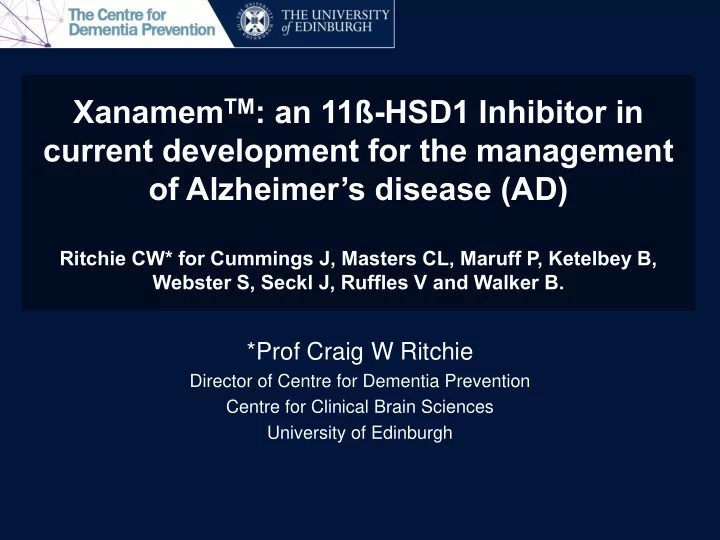

Xanamem TM : an 11ß-HSD1 Inhibitor in current development for the management of Alzheimer’s disease (AD) Ritchie CW* for Cummings J, Masters CL, Maruff P, Ketelbey B, Webster S, Seckl J, Ruffles V and Walker B. *Prof Craig W Ritchie Director of Centre for Dementia Prevention Centre for Clinical Brain Sciences University of Edinburgh
Disclosures • I have been supported for travel to this meeting by Actinogen who I also have a consultancy arrangement with through the University of Edinburgh. • I have also provided paid consultancy work over the last 5 years for: – AbbVie, Eisai, Sanofi-Aventis, Merck, Janssen, Nutricia, Novartis, Prana Biotechnology, Actinogen, Roche, Biogen, Lundbeck, Aptiv Solutions and GSK • I also co-lead the EPAD Consortium which is a public:private partnership with several pharmaceutical companies and SMEs
Presentation Overview 1. Role of HPA Axis and Cortisol in Alzheimer’s disease 2. Mechanism of action, pre-clinical and clinical work with central 11 b -HSD-1 Inhibition 3. The Xanadu Study of Xanamem TM in Mild Alzheimer’s Dementia
Elevated circulating cortisol levels may contribute to AD pathogenesis (1,2) . • Direct: [1] increase levels of amyloid precursor protein (APP) and BACE leading to increased A b 42 formation [2] reduced A b 42 degradation via attenuation of insulin degrading enzyme (3) • Indirect: [1] Insulin resistance, [2] angiopathic and antiangiogenic actions [3] increased excitatory (N-methyl-D-aspartate) neurotransmission [4] Increased postsynaptic calcium signaling promoting neurotoxicity metabolic endangerment of neurons, and deleterious alterations in neuroimmune function (4) 1 Peskind ER, et al Neurology . 2001;56:1094 – 1098. 2 Cernansky JG et al AmJPsychiatr y. 2006;163:2164 – 2169. 3 Green KN et al. J Neurosci . 2006;26:9047 – 9056. 4 Wang Y et al . Endocrinology . 2011;152:2704 – 2705.
Plasma cortisol, brain amyloid- b , and cognitive decline in preclinical Alzheimer’s disease: a 6-year prospective cohort study 1 1 Pietrzak RH et al., Biological Psychiatry, Cognitive Neuroscience and Neuroimaging (ePrint) 2016 METHOD •Cognitively normal older adults (n=416) enrolled in the AIBL study underwent Aβ neuroimaging at a single timepoint. Fasted cortisol were dichotomized using a median split procedure. • Five cognitive composites were derived: Episodic Memory, Executive Function, Attention, Language and Global Cognition • Latent growth curve models were conducted to evaluate the relation between baseline plasma cortisol and Aβ levels, other risk factors, and cognitive composite scores over the 72-month study period.
RESULTS •High baseline plasma cortisol levels associated with 2.2 times the risk of Αβ+ and associated with greater decline in global cognition (Cohen’s d=0.42), episodic memory (Cohen’s d=0.69), and attention (Cohen’s d=0.31)*. • *Effects were independent of age, education, premorbid intelligence, APOE and BDNF genotype, subjective memory complaints, vascular risk factors, and depression and anxiety symptoms .
Function of 11 b -HSD1 ACTIVE INACTIVE
METHODS Short Term Study: 14 month old mice: UE2316 10mg/kg/d through SC route (n=20 1:1 active:placebo) Long Term Study: 6-7 month old mice fed UE2316 (n=32) or control diet (n=16) for up to 57 weeks Behaviour : Memory in Passive Avoidance, Y-Maze Testing, Open Field Testing, Spontaneous Alteration and Morris Water Maze Immunohistochemistry Cortical Amyloid Plaque Number and Plaque Area (Sooy et al., Endocrinology 156: 4592 – 4603, 2015)
11 b -HSD1 Inhibition in TG2476 Mice Selected Behavioral Improvements Reduced Amyloid Plaque Burden Impact of 11 b -HSD-1 inhibition on [A] Impact of 11 b -HSD-1 inhibition on [A] Open field [B] Spontaneous Alteration Short Term Plaque Number, [B] Short and [C] Morris Water Maze term Plaque Area and [C] Long Term Plaque Number (Sooy et al.Endocrinology 156: 4592 – 4603, 2015)
In two double-blind, placebo RCT crossover studies, carbenoxolone • Improved verbal fluency ( P < 0.01) after 4 weeks n=10 elderly men (aged 55 – 75 y) • Improved verbal memory ( P < 0.01) after 6 weeks n=12 type 2 diabetics (52 – 70 y). Sandeep et al. 11-Hydroxysteroid dehydrogenase inhibition improves cognitive function in healthy elderly men and type 2 diabetics. Proc Natl Acad Sci USA . 2004;101:6734 – 6739
Summary of Background • Strong biological basis for aetiological role of elevated central cortisol in AD pathology. • Epidemiological work associates elevation of cortisol with AD pathology and clinical progression • Interventions studies in pre-clinical and clinical models with 11- b HSD1 showing promise • Rational target for further clinical trials for symptomatic and potentially disease modifying treatments for Alzheimer’s dementia.
XanADu (Xanamem in AD) • A Phase II, Double Blind, 12-Week, Randomised, Placebo-Controlled Study to Assess the Safety, Tolerability and Efficacy of Xanamem™ in Subjects with Mild Dementia due to Alzheimer’s Disease • Primary objective: Performance of Xanamem™ from Baseline to end of treatment compared to placebo in ADAS-Cog v14 (2 points) & ADCOMs • Secondary objectives include RAVLT, CDR-SOB, MMSE, NPI &NTB (exec)
XanADu (Xanamem in AD) • Key subject inclusion criteria includes: – Mild dementia due to Alzheimer’s disease – MMSE 20 to 26 (inclusive) – CDR of 0.5 to 1.0 – On a stable dose of acetylcholinesterase (AChEI) and/or memantine (at least 3 months prior to Screening) OR treatment- naïve. Initiating AChEIs or memantine during the study will not be permitted
XanADu (Xanamem in AD) • Initiating in US, Australia and UK in 2017 • 174 patients with mild Alzheimer’s dementia to be randomised • Excellent PK and Brain Penetrance to achieve optimal central 11b-HSD1 inhibition with no/minimal peripheral effects
Summary • Epidemiological, biological and (limited) trial evidence associates elevations in cortisol with Alzheimer’s disease and clinical progression. • 11 b -HSD1 Inhibition is a targetable and rational approach to symptomatic and disease modification in Alzheimer’s disease. • The XanADu study is the first Phase 2 trial of Xanamem for symptomatic benefit in Mild Alzheimer’s dementia – initiating in 2017.
Recommend
More recommend